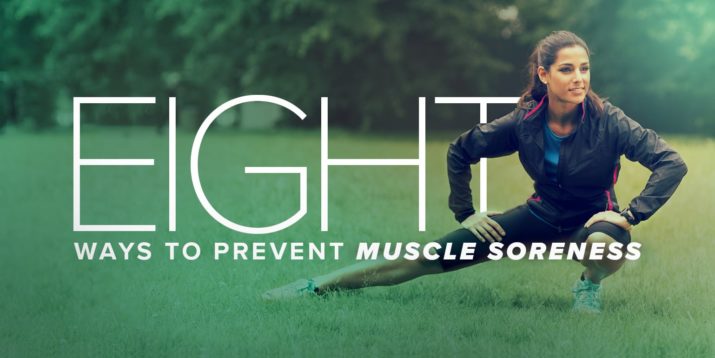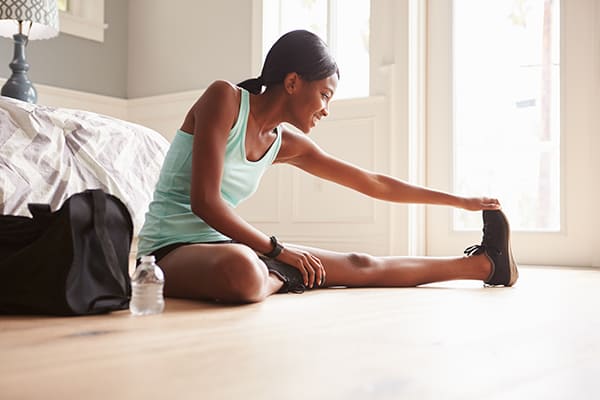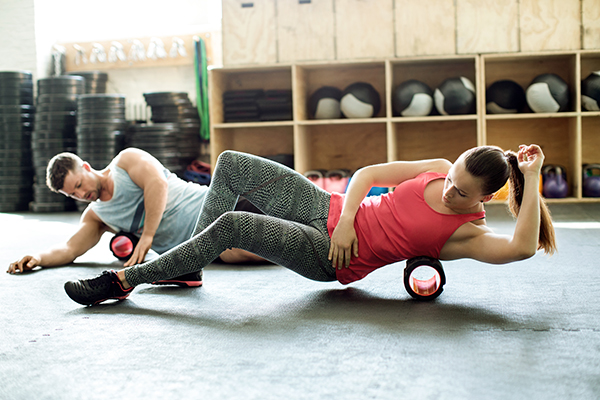Recovery Done Right: 8 Ways to Relieve Sore Muscles

Aching after a brutal workout? A common misconception is that sore muscles are a sign of an excellent workout, and it’s proof that your body is making changes in a positive direction.
But the truth is that sore muscles and workout quality don’t go hand in hand.
It usually just means you pushed yourself too hard or you’re doing new exercises. There are even steps you can take to avoid muscle soreness from the get-go.
Even though muscle soreness isn’t a necessity when you’re working to get results, it can creep up on you.
Delayed onset muscle soreness (DOMS) can make you feel the burn while your muscles recover and rebuild. But if you take the right steps after your workout, you can go hard without paying the price.
Here are eight easy ways to prevent post-workout pain.
What Are Sore Muscles?
Before we dive into how to relieve muscle soreness, it helps to know why you get sore muscles in the first place.
When you exercise intensely, that can cause micro-tears in your muscle tissue, which leads to delayed onset muscle soreness, or DOMS.
This typically develops 12 to 24 hours after a tough workout and can linger for two or three days.
The most common symptoms of DOMS include slight swelling, stiffness, reduced range of motion in the affected joints, and increased tenderness and reduced strength in the affected muscles.
How to Relieve Sore Muscles
No matter how hard you try to avoid it, sometimes you’re going to overwork your body and find yourself in some pain after a workout.
Exercise-induced muscle soreness usually fades within a few days, but if you’d like to speed things up, follow these tips to help you get on the fast track to feeling 100 percent.
1. Stretch
Stretching is your first line of defense after a good workout. When you train, you contract your muscles, and the muscle fibers get shorter.
Lengthening them after a workout promotes mobility, and can lead to a more thorough recovery.
While fitness experts can’t seem to agree on this strategy — one Australian study claims that stretching had no impact on sore muscles — it certainly won’t hurt, especially if your flexibility is limited.
If you’re new to stretching (or at least new to stretching routines), check out five of our favorite total-body mobility moves.

2. Foam roll
Using a foam roller to massage your sore muscles after a workout can significantly reduce DOMS, according to a recent study in the International Journal of Sports Physical Therapy.
Give each major muscle group at least five rolls, starting with your calves and working your way up your body.
Spend extra time on sore spots.
For a more detailed tutorial on foam rolling, check out Tai Cheng.
3. Massage your sore spots
Don’t limit foam rolling to your post-workout routine. Do it between workouts to ease muscle soreness and boost mobility.
Indeed, to see significant improvements in the latter, you have to foam roll even on the days you don’t train, report scientists at the University of Oregon.

4. Eat for rapid recovery
Even if you’re eating at a calorie deficit, you want to make sure to get enough healthy proteins, carbohydrates, and fats, all of which play important roles in repairing and maintaining muscles and warding off sore muscles.
Beyond that, consider strategically timed protein supplementation.
A couple of hours after working out and when you sleep are two times when protein synthesis (muscle repair) increases, so a post-exercise/pre-bedtime scoop of Beachbody Performance Recover can help ensure your body access to amino acids.
“Amino acids are your body’s building blocks,” explains Denis Faye, M.S., and former executive director of nutrition at BODi. “Consuming them at the right times assures they’ll be there when you need them.”
Beachbody Performance Recover also helps you fight post-workout pain by including pomegranate extract into its formula, which a study at the University of Austin, in Texas, found to reduce exercise-induced muscle soreness by an average of 25 percent.
5. Get heated
Heat increases circulation, especially focused heat like that of a Jacuzzi, making it a powerful recovery tool between workouts — emphasis on “between workouts.”
Immediately after a training session, such heat can exacerbate inflammation, and the jets can pound your already-damaged muscles, resulting in more muscle soreness instead of less.
6. Favor fatty acids
“When your muscles are sore, inflammation is a significant part of the problem,” says Faye.
To help reduce this inflammation, consume foods that are rich in omega-3 fatty acids — such as salmon, free-range meat, flax, avocado, and walnuts — to your diet.
The natural anti-inflammatory properties of these foods can help dial back soreness after overexertion.
7. Keep moving
The last thing you want to do when everything hurts is to move, but that’s exactly what you need to do.
These workouts are designed to help your body work out kinks and soreness.
They can be used anytime you need them, can’t be done too often, and always leave you feeling much better than before you started.
If your program doesn’t have a recovery workout, a gentle yoga class or going on an easy hike is a good option.
Fitness pros call this kind of activity “active recovery,” and if you find yourself winded or unable to hold a conversation while you do it, you’re overexerting yourself.
If you want to be technical about it, wear a heart rate monitor and stay below 140 beats per minute.
8. Ice it
Immediately after a tough workout, icing your muscles can stave off inflammation.
“Inflammation is one of nature’s defense mechanisms, but it works like a cast — it immobilizes you,” according to Steve Edwards, former Vice President of Fitness and Nutrition at Beachbody.
“When you keep inflammation down, that area is free to keep moving, and movement promotes healing.”
Like stretching, its effectiveness is up for debate — some researchers have claimed that ice is only effective for injuries and not for run-of-the-mill soreness, but it’s a simple and safe option that many top-level athletes swear by.
“Unless you ice so long that you give yourself frostbite, there’s really no danger,” Edwards says. “It seems to really speed up healing without any adverse effects.”
Are You Too Sore to Work Out?
Sometimes you can power through a workout with sore muscles, but sometimes it feels downright impossible.
If you’re unsure what to do, follow our advice on how to decide if you should lace up your workout shoes or take a rest day.
Should You Take a Painkiller to Relieve Muscle Soreness?
Popping some vitamin I (the street name for nonsteroidal anti-inflammatory drugs [NSAID] such as ibuprofen, naproxen, and aspirin) can significantly reduce exercise-induced muscle soreness, but that relief might come at a price.
An ever-growing body of research has linked NSAIDs (including ibuprofen) to everything from cardiovascular issues and intestinal dysfunction to suppressed protein synthesis post-exercise.
Occasionally taking a couple of capsules for muscle soreness is probably fine — but give some serious thought to using it regularly.
For more information on this topic, check out the following studies:
Resources: Donnelly AE, Maughan RJ, Whiting PH. Effects of ibuprofen on exercise-induced muscle soreness and indices of muscle damage.
Gorsline RT1, Kaeding CC. The use of NSAIDs and nutritional supplements in athletes with osteoarthritis: prevalence, benefits, and consequences. Clin Sports Med. 2005 Jan; 24(1):71–82.
Rahnama N, Rahmani-Nia F, Ebrahim K. The isolated and combined effects of selected physical activity and ibuprofen on delayed-onset muscle soreness. Journal of Sports Science. 2005 Aug; 23(8): 843–50.
Trelle S1, Reichenbach S, Wandel S, Hildebrand P, Tschannen B, Villiger PM, Egger M, Jüni P. Cardiovascular safety of non-steroidal anti-inflammatory drugs: network meta-analysis. BMJ. 2011 Jan 11; 342:c7086. doi: 10.1136/bmj.c7086.
Warden SJ. Prophylactic use of NSAIDs by athletes: a risk/benefit assessment. Phys Sportsmed. 2010 Apr; 38(1):132-8. doi: 10.3810/psm.2010.04.1770.
Wharam PC, Speedy DB, Noakes TD, Thompson JM, Reid SA, Holtzhausen LM. NSAID use increases the risk of developing hyponatremia during an Ironman triathlon. Medicine and Science Sports and Exercise. 2006 Apr; 38(4): 618–22.
